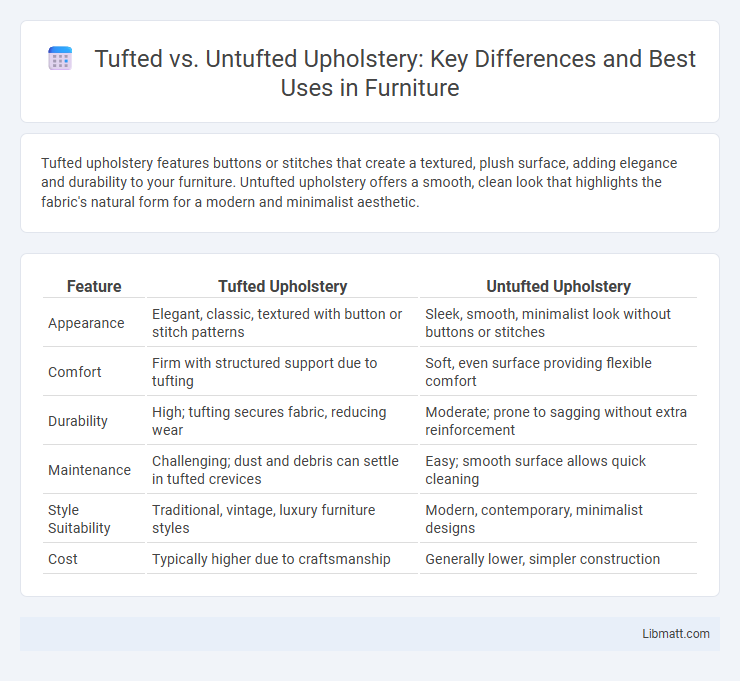Tufted upholstery features buttons or stitches that create a textured, plush surface, adding elegance and durability to your furniture. Untufted upholstery offers a smooth, clean look that highlights the fabric's natural form for a modern and minimalist aesthetic.
Table of Comparison
| Feature | Tufted Upholstery | Untufted Upholstery |
|---|---|---|
| Appearance | Elegant, classic, textured with button or stitch patterns | Sleek, smooth, minimalist look without buttons or stitches |
| Comfort | Firm with structured support due to tufting | Soft, even surface providing flexible comfort |
| Durability | High; tufting secures fabric, reducing wear | Moderate; prone to sagging without extra reinforcement |
| Maintenance | Challenging; dust and debris can settle in tufted crevices | Easy; smooth surface allows quick cleaning |
| Style Suitability | Traditional, vintage, luxury furniture styles | Modern, contemporary, minimalist designs |
| Cost | Typically higher due to craftsmanship | Generally lower, simpler construction |
Introduction to Upholstery: Tufted vs Untufted
Tufted upholstery features a distinctive pattern created by securing fabric with buttons or stitches, adding texture and durability to furniture. Untufted upholstery offers a smooth, clean surface, emphasizing simplicity and modern design. Your choice between tufted and untufted upholstery influences both the aesthetic appeal and maintenance requirements of your furniture.
What is Tufted Upholstery?
Tufted upholstery features fabric or leather tightly stitched through the cushion and secured with buttons or knots, creating a series of raised, textured patterns that add depth and elegance to furniture. This technique enhances durability by holding the padding firmly in place, preventing shifting or sagging over time. When choosing your upholstery, tufted designs offer a classic, sophisticated look that combines both style and structural integrity.
What is Untufted Upholstery?
Untufted upholstery features a smooth, flat surface without sewn or buttoned indentations, offering a sleek and modern look. This style provides greater flexibility in fabric selection and easier cleaning, making it ideal for minimalist and contemporary furniture designs. Untufted upholstery allows for a more streamlined appearance, emphasizing fabric texture and color over decorative detailing.
Visual Appeal: Comparing Tufted and Untufted Styles
Tufted upholstery features buttons or stitches that create a textured, plush surface, offering a classic and elegant visual appeal ideal for creating focal points in your living space. Untufted upholstery presents a smooth, clean look that complements modern and minimalist interiors by emphasizing simplicity and sleek lines. Choosing between tufted and untufted styles depends on your design preference, with tufted adding depth and character, while untufted enhances a streamlined, contemporary aesthetic.
Comfort and Support Differences
Tufted upholstery offers enhanced comfort and support by securing cushioning with buttons or stitches, creating a firmer and more structured surface that maintains shape over time. Untufted upholstery provides a softer, more plush feel with looser cushioning that adapts easily to body contours for relaxed seating. The choice between tufted and untufted significantly influences the overall support level and durability of upholstered furniture.
Durability and Maintenance Factors
Tufted upholstery typically offers enhanced durability due to its reinforced stitching and closely secured fabric, preventing sagging and wear over time. Untufted upholstery allows for easier maintenance since it lacks deep creases where dust and debris can accumulate, making cleaning more straightforward. Your choice should balance the desire for long-lasting fabric resilience with the practicality of upkeep requirements.
Cost Considerations: Tufted vs Untufted
Tufted upholstery typically costs more than untufted due to the intricate stitching and additional labor involved in creating the tufted design, which increases production time and material use. Untufted upholstery offers a more budget-friendly option, as its simpler construction requires less time and fewer materials, making it ideal for cost-conscious consumers. Your choice between tufted and untufted upholstery should consider both aesthetic preferences and long-term maintenance expenses, as tufted pieces may require more care to preserve their detailed appearance.
Suitable Interior Design Styles
Tufted upholstery is ideal for classic, traditional, and Victorian interior design styles, adding elegance and texture with its distinctive buttoned or stitched patterns. Untufted upholstery suits modern, minimalist, and contemporary interiors, emphasizing clean lines and a sleek, streamlined appearance. Both options enhance space aesthetics depending on the desired ambiance and decor theme.
Pros and Cons of Tufted Upholstery
Tufted upholstery offers a classic, elegant look with added durability due to the stitched buttons or seams that secure padding, which helps maintain shape over time. You'll benefit from its plush cushioning and decorative appeal, but it can be harder to clean due to recessed areas where dust and dirt collect. While tufting provides structural support and timeless style, it may not suit minimalist designs or households with pets and children prone to spills.
Pros and Cons of Untufted Upholstery
Untufted upholstery offers a sleek, modern appearance with smooth surfaces that are easier to clean and maintain, making it ideal for high-traffic areas and busy households. Its minimalist design allows for greater versatility in fabric patterns and colors, while also providing a softer, more comfortable seating experience without the indentations tufting creates. However, untufted pieces may lack the structured support and classic elegance timbered upholstery brings, potentially leading to quicker fabric sagging over time.
Tufted vs Untufted Upholstery Infographic

 libmatt.com
libmatt.com